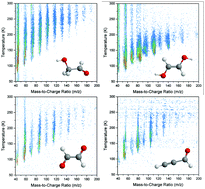On the formation of complex organic molecules in the interstellar medium: untangling the chemical complexity of carbon monoxide–hydrocarbon containing ice analogues exposed to ionizing radiation via a combined infrared and reflectron time-of-flight analysis†
Abstract
Recently, over 200 molecules have been detected in the interstellar medium (ISM), with about one third being complex organic molecules (COMs), molecules containing six or more atoms. Over the last few decades, astrophysical laboratory experiments have shown that several COMs are formed via interaction of ionizing radiation within ices deposited on interstellar dust particles at 10 K (H2O, CH3OH, CO, CO2, CH4, NH3). However, there is still a lack of understanding of the chemical complexity that is available through individual ice constituents. The present research investigates experimentally the synthesis of carbon, hydrogen, and oxygen bearing COMs from interstellar ice analogues containing carbon monoxide (CO) and methane (CH4), ethane (C2H6), ethylene (C2H4), or acetylene (C2H2) exposed to ionizing radiation. Utilizing online and in situ techniques, such as infrared spectroscopy and tunable photoionization reflectron time-of-flight mass spectrometry (PI-ReTOF-MS), specific isomers produced could be characterized. A total of 12 chemically different groups were detected corresponding to C2HnO (n = 2, 4, 6), C3HnO (n = 2, 4, 6, 8), C4HnO (n = 4, 6, 8, 10), C5HnO (n = 4, 6, 8, 10), C6HnO (n = 4, 6, 8, 10, 12, 14), C2HnO2 (n = 2, 4), C3HnO2 (n = 4, 6, 8), C4HnO2 (n = 4, 6, 8, 10), C5HnO2 (n = 6, 8), C6HnO2 (n = 8, 10, 12), C4HnO3 (n = 4, 6, 8), and C5HnO3 (n = 6, 8). More than half of these isomer specifically identified molecules have been identified in the ISM, and the remaining COMs detected here can be utilized to guide future astronomical observations. Of these isomers, three groups – alcohols, aldehydes, and molecules containing two of these functional groups – displayed varying degrees of unsaturation. Also, the detection of 1-propanol, 2-propanol, 1-butanal, and 2-methyl-propanal has significant implications as the propyl and isopropyl moieties (C3H7), which have already been detected in the ISM via propyl cyanide and isopropyl cyanide, could be detected in our laboratory studies. General reaction mechanisms for their formation are also proposed, with distinct follow-up studies being imperative to elucidate the complexity of COMs synthesized in these ices.

- This article is part of the themed collection: 2019 PCCP HOT Articles


 Please wait while we load your content...
Please wait while we load your content...